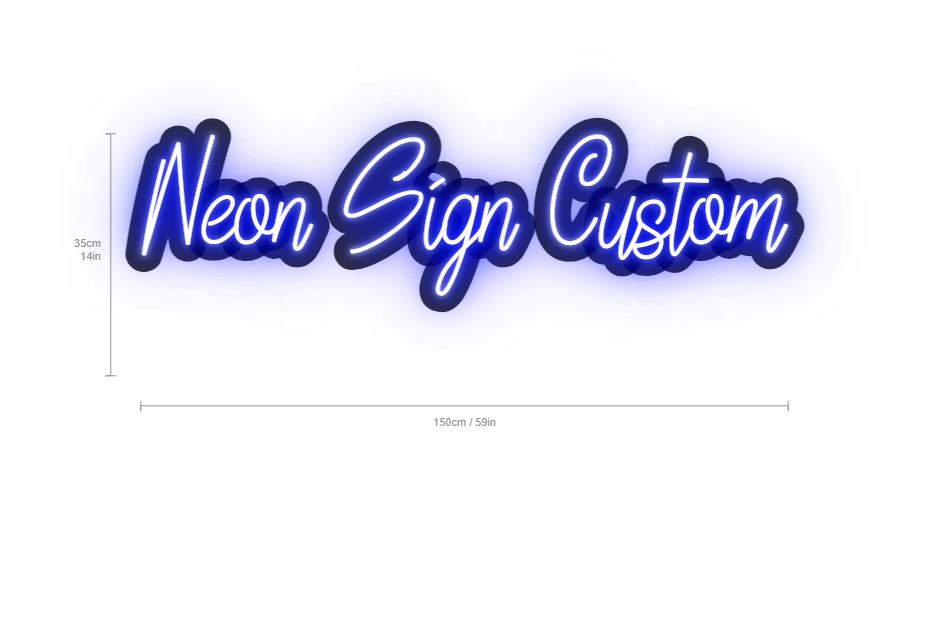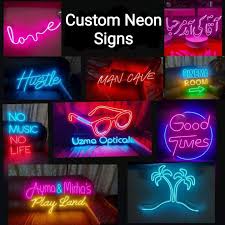Customizing a neon sign involves several key considerations and steps, allowing for a personalized touch that reflects the desired message, brand identity, or aesthetic. Here’s a detailed exploration of these factors:
1. Purpose and Message
The first step in customizing a neon sign is determining its purpose. What message do you want the sign to convey? Is it for a personal space, like a home bar or bedroom, or for a business, such as a storefront or event? Here are some considerations:
-
Personal Use: For personal spaces, consider messages that reflect your personality, hobbies, or significant quotes. This might include phrases like “Live Laugh Love,” a favorite song lyric, or even a custom design that represents a passion or interest.
-
Business Use: For businesses, the sign should reflect the brand’s identity. Consider including the business name, logo, or a tagline. Ensure that the design aligns with your brand colors and style. For instance, a coffee shop might opt for warm colors and inviting phrases, while a bar might go for vibrant colors and edgy fonts.
2. Design Elements
Once you have a clear message, it’s time to think about the design elements of the neon sign:
-
Font Style: The choice of font is critical in conveying the right tone. A fun, cursive font may be suitable for a playful brand, while a bold, sans-serif font may be more appropriate for a modern, minimalist aesthetic.
-
Color Scheme: Neon signs are known for their vibrant colors. Selecting the right colors can evoke specific emotions and attract attention. For example:
- Warm Colors (Red, Orange, Yellow): These colors tend to be inviting and energetic, making them suitable for restaurants or entertainment venues.
- Cool Colors (Blue, Green, Purple): These colors can convey calmness and sophistication, ideal for spas or wellness centers.
-
Size and Shape: Consider where the sign will be placed. The size should be appropriate for the space. A small sign may get lost on a large wall, while a gigantic sign could overwhelm a small room. The shape of the sign should complement its content—circular signs may look inviting, while rectangular shapes can convey professionalism.
3. Materials and Construction

Understanding the materials used in customizing neon signs is essential for durability and aesthetics:
-
Neon vs. LED: Traditional neon signs use glass tubes filled with neon gas, while modern neon signs often use LED lights. Each has its pros and cons:
- Neon Signs: They offer a classic look and are highly customizable but can be fragile and require more maintenance.
- LED Neon Signs: These are more durable, energy-efficient, and safer. They can be molded into various shapes and are easier to install.
-
Backing Material: The sign can be mounted on different materials, such as acrylic, wood, or metal. The choice of backing can impact the overall look and installation process.
4. Installation Location
Where the sign will be displayed significantly influences its design and functionality:
-
Indoor vs. Outdoor: If the sign is for indoor use, the focus can be on aesthetic appeal. For outdoor signs, consider durability and weather resistance. Ensure that the materials used can withstand outdoor conditions.
-
Visibility and Lighting: Assess the lighting conditions of the area. If the sign will be in a brightly lit environment, brighter colors or a larger size may be necessary for visibility.
5. Customization Options
There are numerous ways to customize your neon sign beyond basic text and colors:
-
Custom Shapes: Signs can be made in unique shapes that represent a business logo or a specific design. This added element can enhance branding and visual interest.
-
Animations: Some modern neon signs can incorporate animations or changing colors, adding a dynamic aspect to your sign. This feature can be particularly eye-catching for businesses looking to attract customers.
-
Dimming Features: For added flexibility, consider a sign that allows you to adjust brightness. This feature can be especially useful in restaurants or bars, where ambiance is crucial.
6. Budgeting and Costs
Cost is a significant factor in customization:
-
Price Range: The price of neon signs can vary widely based on size, complexity, and materials. Simple LED signs may start as low as $50, while larger, customizing neon signs can cost several hundred dollars.
-
DIY vs. Professional Services: If you have a tight budget, consider making a DIY neon sign using LED neon flex. This option can be more affordable and allows for creative freedom. However, professional services often ensure a higher quality finish and durability.
-
Shipping and Installation Costs: Don’t forget to account for any shipping fees if purchasing online and the potential costs of professional installation.
7. Permits and Regulations
If you’re placing a neon sign outdoors, be aware of local regulations:
-
Zoning Laws: Different areas have specific rules regarding signage, including size, lighting, and placement. Research local zoning laws to ensure compliance.
-
Permits: You may need a permit for outdoor signage, especially if it’s large or illuminated. Check with local authorities for any requirements before installation.
8. Maintenance and Care
After your neon sign is installed, maintaining its appearance and functionality is essential:
-
Cleaning: Regular cleaning is necessary to keep the sign looking its best. Use a soft cloth and a mild cleaning solution, avoiding harsh chemicals that could damage the materials.
-
Troubleshooting: If the sign flickers or goes out, it may be a sign of a loose connection or a burnt-out bulb. Familiarize yourself with troubleshooting steps or have a professional available for repairs.
9. Sustainability Considerations
As more people become environmentally conscious, consider sustainability in your customization:
-
Energy Efficiency: LED signs are generally more energy-efficient than traditional neon, using less power and lasting longer. Opting for LED can be a more sustainable choice.
-
Recyclable Materials: If possible, choose customizing neon signs made from recyclable materials or those that can be easily disassembled for recycling at the end of their life cycle.
10. Choosing a Custom Sign Maker
Selecting the right vendor is crucial for quality and satisfaction:
-
Research: Look for reputable companies with positive reviews. Check their portfolios to see examples of their work and assess the quality of their signs.
-
Consultation: Many custom sign makers offer consultations. Use this opportunity to discuss your ideas, get expert advice, and ensure the designer understands your vision.
-
Quotes and Timelines: Request quotes from multiple providers and ask about their turnaround times. This step will help you find a service that fits your budget and timeline.
Conclusion
Customizing a neon sign is a multifaceted process that allows for creativity and personalization. By considering the purpose, design elements, materials, installation location, and other factors, you can create a sign that effectively communicates your desired message while enhancing the visual appeal of the space. Whether for personal use or business branding, a neon sign can be a unique and impactful way to express identity and attract attention.
Ultimately, the key to a successful neon sign lies in thoughtful planning and execution, ensuring that every element aligns with your vision and goals. With the right approach, your customized neon sign can become a striking focal point that captures attention and resonates with your audience, illuminating your space with style and personality.




